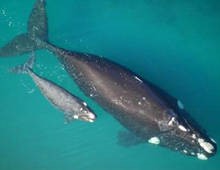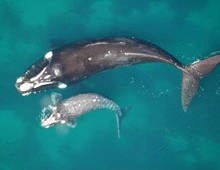Reproduction
Southern Right Whales (Eubalaena australis) mate and calve
during the winter calving season of June spanning until late
October or early November. Peak calving takes place in August.
This baleen whale species is polygamous. During copulation one
might observe as many as seven males to a single female.
Reproduction takes place in one of four major breeding grounds:
Argentina, South Africa, Australia and New Zealand (NMFS, 2007;
Patenaude et al., 2007). Females mate every third year and it is
common for them to travel long distances to reach a mating
ground during this year (Burnell, 2001). Females are more likely
to frequent the same mating site than are their male
counterparts.
The actual reproduction can be observed beginning near the
surface of the water. A single female rolls onto her back holding
her breath for long periods of time, in an attempt to hide her
genital slit until she is ready to mate. Male Eubalaena australis in
a group of 3-7 whales join her and disrupt the water by rubbing
bodies and stroking flippers. When the female is prepared to mate
she rolls into a berthing position. Males pull along side the female
(stroking her back with a flipper) or rise from underneath her. The
male performs a roll and sinks under the female to mate belly up.
The unsheathed E. australis penis is extremely motile and eventually
ejaculates gallons of sperm into the female. Several males will
attempt to (successfully) mate with the female until she breaks
away. Due to the large quantities of semen expelled in each
ejaculation, the last whale may have the greater chance of
impregnating the female than the initial whale (Best et al,. 2010).
This mating may last from 1 to 2 hours. The female undergoes a
gestation period of 365 days (1 year) before producing one offspring
which will accompany her for the following year. Female E. australis
use the following year to replenish their stores of energy before
beginning the breeding cycle again.
The Eubalaena australis are separated into three age categories:
calf, juvenile and adult. Calves are small in size and consistently
observed with a large whale. Juveniles are smaller than adult female
yet larger than calves. At this age the whales lose the dip in their
posterior which was observed in calves. Identifying juveniles is
more ambigious than calf or adult. Adult E. australis are large and
sexually mature. E. australis reach sexual maturity at age 9 or 10
in both male and females. It is difficult for even a qualified
biologist to distinguish male from female Eubalaena australis.
Female Eubalaena australis are slightly larger than males. However the size difference is not statistically significant as there is a great deal of overlap. A male E. australis can be immediately identified by the presence of a penis. The male E. australis has the largest whale penis (approx. 12 ft) and the largest testes of any mammal, which weigh up to a ton. Despite their size, penis sighting are uncommon.
Both male and female Eubalaena australis have a genital slit on
their ventral side. The male genital slit is more than two times as
long as the female genial slit. The whales’ white ventral coloring
masks size of the slit for the untrained eye. The location of the
genital slit is varied between the sexes. The male E. australis
genital slit originates near the umbilicus and the females further
posterior. The males slit branches into a Y towards the whales
posterior while the females does not bifurcate. Another distinctive
characteristic of male E. australis is an anus distinctly separate
from the genital slit. The anus is located towards the posterior end
separated from the genital slit by a distance approximately equal to
the slit. The anus is distinctive, slightly raised and appearing
similar to a tiny volcano. Sighting of an anus without genital slit
is a definite male status. Biologists cannot assume a whale is
female solely based on unobserved separate anus unless absolutely
certain an anus would have been seen if present. (Payne, et al.,
1983). In females, the genital slit is not separate from the anus.
Males have been observed with uniform and smooth genital slits while
reproductive females display creased and uneven slits.
Female Eubalaena australis have easily observable mammary slits
on either side of their genital slits. This observation leads to a
fairly conclusive sex identification although there have been
instances when this trait appeared in males. Nipples are seen only
on reproductive females. Lactation typically occurs for 4-6 months
before the calf is weaned. Female E. australis may have protruding
nipples even after their calf is weaned. Similar to other mammals,
one nipple may be significantly larger than the other due to the
calf feeding on one teat more frequently.
It is difficult to observe both the dorsal and ventral sides,
without information from both distinguishing physical differences
can be challenging. As a result, biologists may resort to behavioral
norms to distinguish sex (Best et al,. 2010). Reproductive females
are identified due to their association with calves. These whales
travel very little and stay close to shore, where these Eubalaena
australis are more frequently observed. These mothers are observed
facing their ventral side to the sky to either avoid nursing or play
with their calves (a distinctly non male characteristic). Although
mature E. australis are polygamous, the calves appear to
monogamously cling to one adult. The female and her calf tend to
stay isolated from other whales during the calves first year.
Identifying a male through behavior patterns is based on three
main criteria.
1. A number of consecutive years being seen as an adult without a
calf. This is evidence of sex as females are rarely without their
calves. Females bear calves about every there years and are only
observed on years of reproduction.
2. A whales participation in a mating group. This group is
categorized as three-seven mature E. australis huddled together by
no less than the length of one whale. These groups are observed near
the surface and create white water as a result of their rolling,
turning and diving.
3. A whale observed as a companion to another known male. In
non-mating situations males tend to associate with other males
(Payne, et al 1983).
Eubalaena australis display strong, successful reproductive
abilities. However as a result of whaling massacre their numbers are
still significantly depleted. Rebuilding the population is a slow
and arduous journey for a species in which a female produces a
single offspring only every three years.
Click here to continue onto our Interactions page or go back to our Home page!


